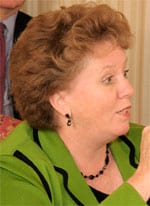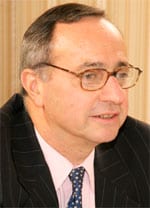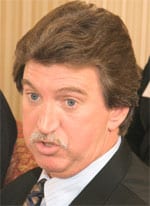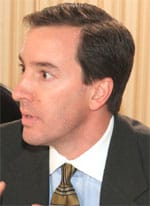 |
|
Alarcon: I hear clients say they are not seeing the full benefits of Check 21 yet |
Skip Heaps,global product executive, global product management, Bank of America: One of the challenges facing all of us is to figure out how to scale back the paper processing and infrastructure at a pace that is not too fast or too slow. Shutting down 25 check processing factories could cause big problems. But if you don’t take out some of the infrastructure and some of the costs, it’s hard to be competitive.
Al Briand,managing director, global payment services, The Bank of New York: It’s an evolution of the business model. Paper is going to be around for a period of time, but it does give us the opportunity to innovate. It also gives us the opportunity as providers to corporates and to other financial institutions to break down some of the silos. In an electronic frame, we’re able to pull things together. We’re able to give information to clients in a much more accelerated, integrated and innovative way.
Patrick Gutmann,senior vice president, head of product management and strategy, transaction banking, ABN Amro: Most clients—even small or mid-market ones—want to migrate to electronic payments, but there are challenges inherent in that migration. For example, the internal processes and controls that today are in place on the check side may be different on the electronic payment side. As banks we can play an important role in assisting clients in the migration toward electronic payments.
Doug Davis,staff director, global cash management, treasury, FedEx: We’re in the middle, with banks that have paper and electronic platforms and customers who want to use new electronic technology. We’re trying to draw customers into the most economical and cost effective system, to give them what they want—and to integrate that with the banks.
Al Carpetto,senior vice president, western hemisphere sales executive, treasury services, JPMorgan Chase: It’s a delicate balance for the banks. JPMorgan Chase wants to be able to process the last check, while at the same time converting and moving our clients into the electronic space. Our customers really drive everything because we manage to meet their needs and expectations.
Andy Yeates,senior vice president, corporate cash management sales, global payments and cash management, HSBC: The use of purchasing cards, corporate cards and other forms of card instruments creates an interesting paradigm for the corporate client. You can take what has been a very paper-intensive environment—payables—and adapt it to an electronic environment via a card transaction. This then allows a corporation to settle thousands of individual transactions via a single payment to the card issuer. Because of the rebate structure on cards, payables is also morphing from a cost center to a profit center.
Briand:Another consequence is that we can provide better customer satisfaction. There are just so many more things we can do in terms of reporting back and the immediacy and completeness of information. There’s so much more that we can do with that payment that ultimately is good news for us as providers, in terms of the breadth of things that we can bring to our client base.
Quinn:Many of our corporate customers want to make things very electronic, but their customers and suppliers aren’t there yet. One of the opportunities we have is to make their connectivity to us totally electronic, and then we manage the paper, end-to-end. We can work with them to convert their customers and suppliers to electronic.
Heaps:Integration and information that helps the client to manage all their data while we’re moving from electronic to paper is critical.
Alarcon:Moving from a paper-based organization to an electronic-type organization requires redesigning business processes and redefining roles and responsibilities. Who is supposed to authorize what in a paper-based organization might not be formalized—but it has to be formalized when you automate the process.
|
|||
|
GF:It’s a year on since the introduction of Check 21. What are its prospects for the future?
 |
|
Gutmann: Customer satisfaction boils down to two critical components: information and integration |
Heaps:I respectfully disagree: Clients absolutely are seeing a benefit, and it actually can be quantified. A simple example is a remote deposit. Instead of shipping a US-dollar-denominated check back to the US, you can scan it wherever you happen to be and present the image of the item on a same-day basis.
Davis:We were one of the first customers to give this service a run. We’re finding that you may be able to eliminate going to the bank but not to eliminate all those bank accounts. I’m not sure we can justify the cost of the hardware at this point, but it’s going to grow anyway, and we are reviewing ways to integrate it and trying to integrate it and use it in a worldwide spread. It has really helped us not having to go to the bank with a lot of checks in an unsecured fashion, though.
Briand:Clients are excited about the benefits they can get from imaging checks from remote locations. But it might be perceived as not taking root because, firstly, clients have to assimilate the changes from an operational point of view and, secondly, image exchange across the banking industry has been slower to take root than was expected.
Gutmann:We’re all seeing explosive growth in remote deposit, primarily as a result of the transparent benefits to our clients. However, image exchange presents a dilemma for banks: Check processing is a declining business, yet we’re all expected to invest heavily. The notion of investing heavily, yet maintaining and managing cost structure in a declining business, leaves us all with some very difficult decisions from a cost-structure management perspective.
Carpetto:As the technology gets better, clients will become more comfortable, and adoption rates will go up. Then companies will start to see that if they don’t implement the newer technologies, it’s going to cost them money. The banks have to and want to be there for the client.
|
|||
|
GF:Are electronic payment channels more vulnerable to fraud than paper? What can companies do to combat all forms of fraudulent transactions?
 |
|
Quinn: Clients want direct access to the information that we have in our back office |
Yeates:The electronic environment is potentially much safer than a paper environment. There’s an incredible amount of technology and security built into the electronic environment, and it’s becoming a much more secure payment arena.
Carpetto:It’s estimated that check fraud ranges from $12 billion to $15 billion annually. Millions of checks are forged, altered or counterfeited each year. On the other hand, people have concerns about electronic payment channels because if there is fraud, it’s usually much larger than what you see for check. However, there are very good security applications in the electronic space. The risk is that clients don’t fully utilize the fraud-mitigation technology.
Gutmann:In a lot of corporations, electronic payments are still handled as a kind of exception process, particularly the corporations that have not wholeheartedly and fully migrated their payment stream. This means they may not have set up the internal controls or articulated the internal processes to the extent that they have with check payments. Often those stringent controls are put in place once they experience some type of fraud.
Davis:It’s incumbent on the corporates to use the commercially reasonable standards that the banks offer, those products that are keeping us safe. If we don’t, it’s on us.
Briand:In bank-sponsored systems, fraud is very low. But people don’t always make the distinction between those and other electronic systems, which might not be so secure. Some of that perception carries over into some of the systems we offer.
Alarcon:With treasury systems and automated bank communications, companies benefit from more secure access controls and transactions. It’s harder to commit fraud in a totally automated environment because you have a number of controls that are embedded in the systems, and committing fraud requires increasingly sophisticated IT-security skills. In addition, auditors have access to audit trails, which make it easier to detect fraud. Lastly, it takes longer to detect fraud in a check environment. It generally takes many more occurrences to find it.
|
|||
|
GF:Payment factories are apparently booming in Asia and Europe and now are about to take off in the US. How are companies employing technologies to support payment factories?
 |
|
Global Finance publisher Joseph Giarraputo: What changes is globalization forcing on treasury? |
Alarcon:Companies are looking at their treasury technology and at how they can leverage this technology to apply to their global electronic payment processes. The same technology that is being used for financial transactions coming out of treasury can be applied to those payment processes originating in other corporate systems. It provides organizations with the capability to group payments internally and send those payments through different banking partners from a unified platform. This also provides full visibility into the companies’ cash outflows—and provides increased forecasting on top of that. In the US, the environment has changed over the past few years with the growth of electronic payments. Now US companies are looking at extending their shared service centers to include their external payment processes or creating dedicated shared service centers for their external payments, also referred to as payment factories. From our perspective, this trend has been around for some time in Europe where more transactions are done electronically.
Quinn:I see it the exact opposite way. In the US we saw a real movement toward shared business services about 10 years ago. At that time the banks were offering services that helped companies generate payments of all different types more efficiently through a single file source. Even 10 years ago in North America companies looked to their bank providers to take a single file from a shared business service center in North America and make other cross-border payments and their local payments. I really think that a lot of those initiatives started here with some of the big global companies, such as FedEx. Now we’re seeing more folks eliminate some of their shared business service centers around the world and consolidate into certain key regions. More importantly, they’re looking to their banks and their technology providers to do single file input of lots of different local currencies.
Heaps:This concept is at least a decade old, but it’s been perfected, and there’s better integration into ERP systems and so forth. The practice of a single payment file-splitting of wires, ACH payments, printing checks, maybe doing multi-currency transactions is probably at least a decade old.
Alarcon:A number of these companies are pulling external payment files from a number of different systems. Technically it’s a real challenge for companies to be able to take those files, group them, convert them, split them by destination, depending on where they need to be communicated to. Then, before the communication is done, the proper workflow has to be applied to those payments. All that is being done in a multinational-type environment where there is maybe one regional unit here and then one in Europe actually processing those payments for all the other countries. This notion of grouping those payments and processing those payments cross border is something that North American businesses from all perspectives have been traditionally less eager to apply than their European counterparts. But from our perspective there is a greater acceptance of the notion of payment factories in North America.
Quinn:It depends on the market segments you’re looking at. A lot of the companies in North America embraced this concept a long time ago, consolidating and integrating their back-office systems into a shared business service center or a payment factory.
Carpetto:Payment factories are taking off in Asia and Europe because these are expanding markets. Domestically we’ve dealt with this, but now there is a global need. It ties right back into the technology question and whether or not the resources are available to invest in technology. Once in a while you come across a treasury department that owns its own IT resources, allowing them to drive their own projects. But in many cases the technology resources are not available internally.
Yeates:There were certainly some first movers here in the United States that were doing this. It just wasn’t a buzzword at the time. There were also companies in Europe and Asia that were looking at this because they had operations in 15 different countries or across 21 different countries and territories in Asia. They were trying to decide whether they should replicate a system 21 times in Asia or, say, once in Singapore. So it caught on there, even though it really started in the US. What is new, in the world of Sarbanes-Oxley, is that you have put control back into companies’ laps, so it’s becoming top-of-mind again, and it’s getting embedded into the companies in the US who didn’t address payment factories when they were first introduced.
Davis:I think the euro drove part of this in the sense that you had a single currency so this became a hot topic. We’ve done it—we set up service centers for EMEA, APAC and the Americas—and it’s been a wonderful thing. It’s been difficult. It takes senior management commitment, it takes IT resources, it takes money and dedication, and you’ve got to find the people and give them the training, but in the end we got there. One of our biggest challenges globally was finding banks that offered the services that allowed us to send a single file in different formats.
|
|||
|
GF:What can banks and technology providers do to improve the level of customer satisfaction and make it easier for customers to do business with them?
 |
|
Briand: We smooth out the variations from country to country to facilitate our customers’ move to globalization |
Gutmann: Customer satisfaction boils down to two critical components: information and integration. With the increased sophistication and complexity of many corporations’ treasury operations, and as more companies are doing more business globally, clients need further information transparency and visibility. Once the information transparency and visibility is there, integration between the client and the banks becomes critically important.
Briand: Sometimes clients say, “I want to just talk with one person when I have an issue.” But what they really need is understandable, integrated, timely information so they don’t have to call that person in the first place. Providing that is the key to customer satisfaction.
Quinn: More importantly, clients want direct access to the information that we have in our back office. If there’s an issue or a concern, they want technology to deliver that either in the form of an alert or a screen they can use to access our internal systems and see where the issue stands. Technology is providing us with all kinds of useful tools, from fraud alerts to electronic documentation management, electronic signatory management and digital signatory management.
Heaps: We all have clients that are small business clients, middle-market clients, large corporate multinational clients, clients in the US, clients overseas. And trying to create one solution for all of them, of course, is folly. You’ll never get there. Actually listening to your clients and understanding that FedEx’s needs are different from XRT’s needs is really important. While there might be some common themes—integration and information and so forth—the way they want it, the time they want it, the currencies they want it in, whether they want push or pull, there are lots of different sorts of variations on that theme. Listen first and then talk about solutions.
Davis: Most of the banks are very open minded and have a good ear, but it is a challenge because there’s so many different things out there that different customers want and need.
Carpetto: JPMorgan Chase develops a menu of services from which our clients can choose. But the key is to be able to successfully tailor those services to support the individual needs of each client.
Yeates: The common theme is fewer touch points. How do we as a bank manage our large infrastructure and provide clients with a single point of contact?
Alarcon: What clients are looking for is the ability to measure how well they do. What we can do is provide them relevant measures or tools that corporates can use to assess their relationship with their banking partners.
|
|
|
Moderated by Joseph Giarraputo






